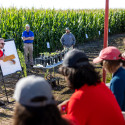UW joins national campaign against binge drinking
A national campaign aimed at raising public awareness of the dangers of high-risk binge drinking by young people is being launched Friday, Sept. 10, with full-page advertisements appearing in dozens of newspapers around the country and a web site providing information about binge drinking on college campuses.
 Students play basketball at the SouthEast Recreation Facility during SERF/Nat After Hours, a program offering late-night alternatives to alcohol consumption. Photo: Brian Moore More information The campaign’s web site ESCAPE: A web site calendar that features local events with low or no alcohol. |
The UW System, UW–Madison and UW-Milwaukee have signed on to the campaign launched by the National Association of State Universities and Land-Grant Colleges (NASULGC), 113 member institutions and the Kellogg Commission on the Future of State and Land-Grant Universities.
Through a number of programs administered by the Dean of Students Office, University Health Services and University Housing, UW–Madison is trying to take the focus off of alcohol, and help those students who do drink see that alcohol is only a small part of their lives.
Every campus of the UW System has initiatives that aim to stem alcohol abuse. The Madison campus is in the middle of a six-year Robert Wood Johnson funded project to change the culture of high-risk drinking at UW–Madison. Madison is one of a number of campuses launching “social marketing” campaigns to change the image and ideas of what college life can be, and to offer a wider range of no-alcohol events both on and off campus.
“Most students want to be responsible. We need to encourage and support them in making responsible choices,” says UW System President Katharine C. Lyall.
Providing alternative activities has been a key in UW–Madison’s concerted campaign to reduce problem drinking and its consequences. For example, the “SERF/Nat After Hours” recreational sports activities that kicked off Sept. 9 at two campus athletic facilities is a good example of how the university can provide activities that help decrease high-risk drinking and its negative consequences (violence, vandalism, property damage, sexual assault and academic failure) among undergraduate students.
Meanwhile, the ads will appear in dozens of newspapers across the country including the New York Times, USA Today, the Wall Street Journal, the Los Angeles Times and the Chicago Tribune.
The ads feature a mock advertisement for a product called “Binge Beer,” with the sales pitch for the “product” citing negative things associated with excessive alcohol consumption.
“The abuse of alcohol is one of the most perplexing problems facing higher education,” says Lyall. “It jeopardizes the mission of higher education and substantially increases the risk of injury, disease and death among students.”
Nationally, alcohol is a factor in 40 percent of all academic problems and 28 percent of all dropouts, a Harvard study found.




